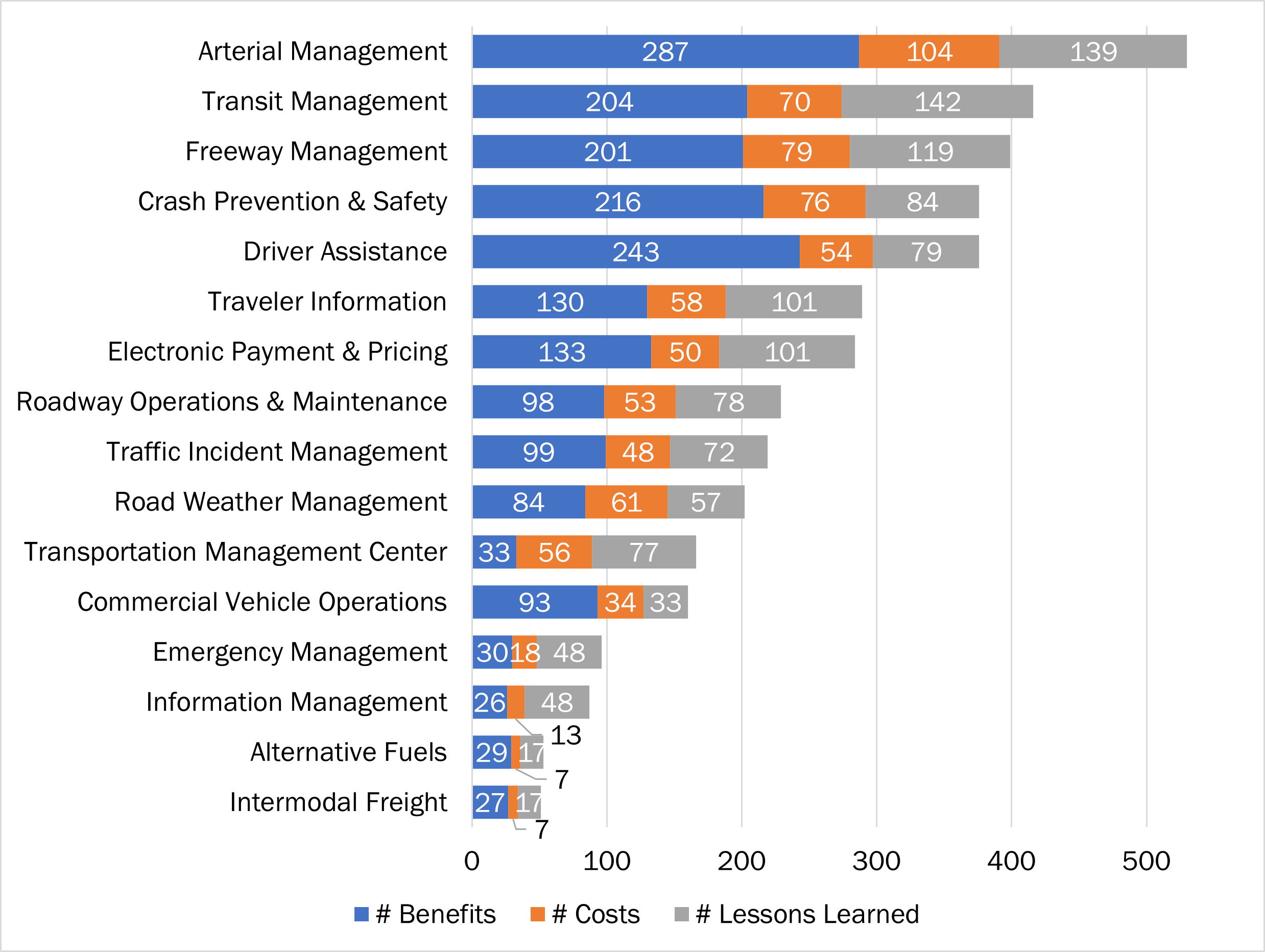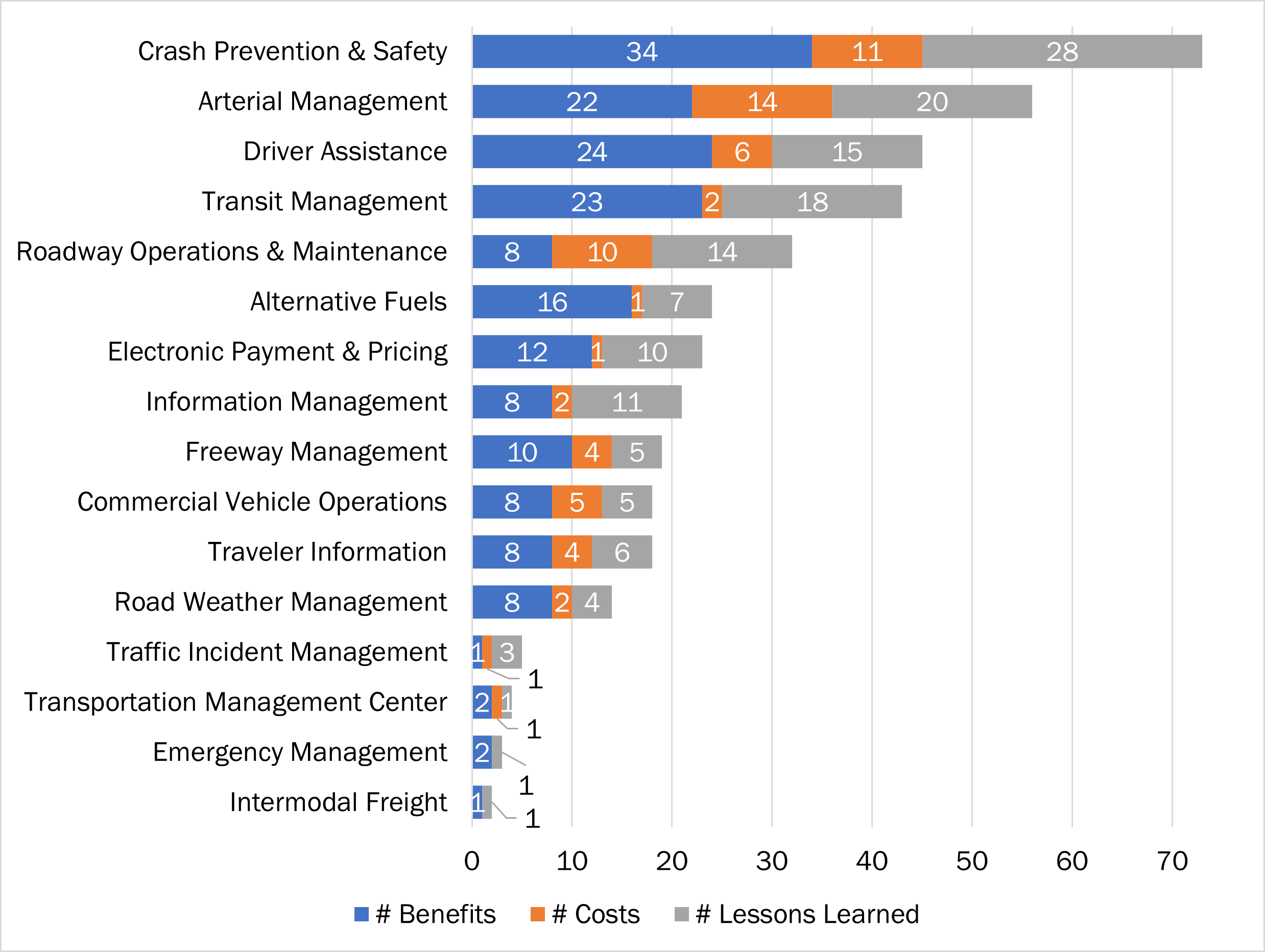Executive Summary (2021)
Introduction
Intelligent transportation systems (ITS) provide a proven set of strategies for advancing transportation safety, mobility, efficiency, and environmental sustainability by integrating communication and information technology applications into the management and operation of the transportation system across all modes. ITS technologies will continue to transform surface transportation with connected and automated vehicles that communicate with each other, the infrastructure, and travelers' wireless devices.
The U.S. Department of Transportation’s ITS research focuses on several high-priority areas including Emerging and Enabling Technologies, Data Access and Exchanges, ITS Cybersecurity Research, Automation, Complete Trip – ITS4US, and Accelerating ITS Deployment. As part of the Accelerating ITS Deployment research area, the ITS Joint Program Office (JPO) Evaluation Program maintains the ITS Benefits, Costs, and Lessons Learned databases that contain over 25 years of evaluation data on the results of specific ITS implementations to support informed decision making by ITS practitioners.
The annual Executive Briefings are developed to highlight the recent additions to the databases on these emerging ITS topics. They are presented in a concise, easily consumable format and can be viewed on a mobile device or tablet, or can be printed for quick reference on one or more topic areas.
Findings
To close out 2021, there were a total of 2,941 entries of ITS benefits, costs, and lessons learned in the databases from the United States and around the world. Figure 1 gives an overview of the summaries in the ITS Benefits, Costs, and Lessons Learned databases by topic (Please Note: a single entry can cover multiple topics).

Of the 2,941 entries, 370 entries have been added since the 2020 Executive Summary. Figure 2 shows the breakdown of new benefits, costs, and lessons learned entries by topic.

2021 Executive Briefing Highlights
In the 25+ years that the ITS JPO has been tracking the evaluation of ITS technologies, there has been steady growth in the number of studies documenting the benefits, costs, and lessons learned of ITS. Every few years, the ITS Evaluation program reflects on recent entries to the databases to assess changing topics and trends. For 2021, eight Executive Briefings have been prepared that feature topic and application areas from Figure 2 as well as emerging research areas in connected and automated vehicle technology and mobility services. Highlights from the eight 2021 Executive Briefings are detailed below.
Advancements in Electronic Fare Payment
- Contactless bank cards and open-loop fare payment technologies are an evolution of electronic fare payment technologies.
- COVID-19-related safety concerns have made these systems more relevant than ever, accelerating their deployment.
- These technologies can reduce system costs and improve the customer experience, but equity issues persist.
Artificial Intelligence and Machine Learning for Transportation
- AI for ITS, an emerging technology field, has the potential to enhance the safety, efficiency, and mobility of the transportation system.
- The GAO has outlined a framework for accountability in AI implementations for government agencies.
- The city of Bellevue, WA used AI machine vision to analyze video data and understand factors that lead to crashes.
ITS for Accessibility
- Trip planning and trip information apps have been found to improve traveler confidence, independence, and service utilization.
- ITS technologies are offering affordable and effective new ways for agencies to serve their customer base.
- USDOT’s numerous projects focusing on transit accessibility can offer key benefits and best practices for deploying similar services.
ITS for Vulnerable Road Users
- While the number of pedestrian fatalities remained relatively stable from 2019 to 2020, deaths of motorcyclists and bicyclists increased by 9 percent and 5 percent, respectively.
- Access Path (a safety app for pedestrians with disabilities) documented lessons learned for design, development and testing of a pedestrian wayfinding app, including using focus groups to determine how best to serve their diverse set of users.
- Drivers using FDOT’s TravelSafety app were less likely to speed when the app alerts were active.
ITS for Work Zones
- In 2019, work zone fatalities saw the largest percentage increase since 2006.
- Agencies are deploying various ITS technologies to manage work zones, including portable variable speed limit signs, work zone intrusion alarms and queue warning systems.
- FHWA is working to increase work zone safety for Connected and Automated Vehicles through the Work Zone Data Exchange (WZDx), an open data specification that facilitates the collection and sharing of live, accurate and actionable work zone data.
Micromobility Services and Equity
- Micromobility services can provide numerous benefits but may raise equity concerns.
- Experience shows that municipalities should strive for equitable service when planning for the deployment of micromobility services.
- Providing alternative payment options, ensuring equitable geographic distribution, and providing information to travelers can improve the micromobility experience for both users and non-users.
Next Generation Transportation Management Centers
- New data sources are enabling greater situational awareness for roadway networks not previously possible under prior generations of traditional infrastructure-based data collection.
- Virginia Department of Transportation study finds that non-traditional messages on highway message boards are more memorable and effective at changing driver behavior.
- The City of Austin, Texas underwent a recent TMC expansion project that resulted in a benefit-cost ratio of 2.4 in 2019.
Virtual and Augmented Reality in Transportation
- Although virtual and augmented reality (VR and AR) are emerging technologies in transportation without return on investment (ROI) data available yet, they are expected to help address transportation challenges in the near future.
- VR and AR could improve driver performance, help with trip planning, improve the transit experience, assist with highway construction, and better protect vulnerable road users.
- Some state Departments of Transportation (DOTs) are beginning to explore the potential of these technologies.
